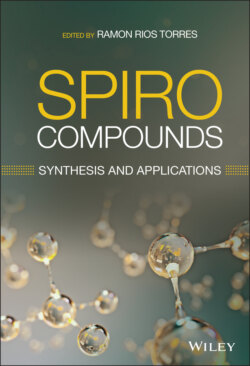Читать книгу Spiro Compounds - Группа авторов - Страница 17
2.5 Further Examples
ОглавлениеThe unique range of properties provided by spirocycles has resulted in the development of a large number of bioactive lead compounds, and would easily deserve the attention of an entire book. These agents are targeting a wide range of protein/enzymes involved in diverse disorders, such as skin conditions, nausea, neurodegeneration, chronic pain, or even malaria. A few representative examples are presented in Figures 2.9 and 2.10. For example, the carba‐spirocyclic natural product Ingenol mebutate (36) acts as a protein kinase C activator, and was approved by the FDA (tradename Picato®) in 2012 for the treatment of actinic keratosis. It can be prepared on a large scale in a protection/acylation/deprotection three step sequence from the naturally abundant ingenol [58]. The aza‐spirocyclic drug Rolapitant (38) is a potent and selective Neurokinin‐1 (NK‐1) receptor antagonist which was recently approved for the prevention of delayed chemotherapy‐induced nausea and vomiting (CINV) in adults, in combination with other antiemetics. Its spirocyclic scaffold can be accessed via the Michael addition of the corresponding nitro‐piperidine onto methyl acrylate, followed by reduction and subsequent lactamization. The oxa‐spirocyclic, investigational molecule Cebranopadol 40 is a potent opioid receptor agonist, and is currently under development for the treatment of a range of acute and chronic pain conditions. Key to the synthesis of 40 is a Lewis acid‐mediated oxa‐Pictet–Spengler reaction of the substituted parent cyclohexanone and indole fragments [59]. Of note, a review of the recent literature shows that five‐ and six‐membered rings still dominate the pool of spiro compounds. As discussed earlier in this chapter, this trend is not surprising. This is mainly due to their restricted conformation compared with larger ring systems, and the historical synthetic challenges associated with smaller ones. It is expected that the developments of synthetic methods to prepare four‐membered heterocyclic spiro systems in the last decade will naturally lead to a better representation of these features in the literature [60].
Figure 2.9 Representative examples of spirocyclic bioactive lead molecules.
Figure 2.10 Additional examples further illustrating the breadth of ring types and sizes found in lead molecules of medicinal chemistry interest.
